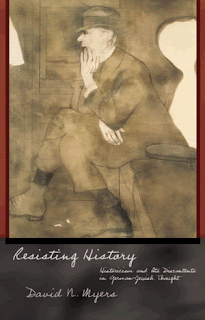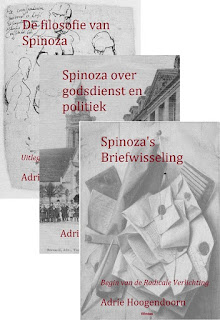Spinoza in de joodse historiografie [8] David N. Myers
De zoektocht levert interessante resultaten op naarmate we bij studenten van Yosef Hayim Yerushalmi en Amos Funkenstein terecht komen.
 David N. Myers is hoogleraar joodse geschiedenis en hoofd van de afdeling geschiedenis van de Universiteit van California in Los Angeles. Hij studeerde in Tel Aviv en Harvard en behaalde zijn doctorsgraad in 1991 aan de Columbia Universiteit bij Yosef Hayim Yerushalmi [Van hem was het stuk over Yerushalmi & Spinoza dat ik citeerde in het blog “Spinoza in de joodse historiografie [5] Yosef Hayim Yerushalmi (vervolg)”]. Zijn bijzondere interesse heeft de geschiedenis van de joodse historiografie. Hij doceerde op vele plaatsen (VS, Frankrijk, Rusland, Israël) en was in de perioden 1996-2000 en 2004-2009 directeur van het UCLA Center for Jewish Studies. Recent heeft hij gepleit voor een nieuwe notie van joods nationalisme, waarbij naast Israël ook andere grote centra van ‘joden in de diaspora’ als gelijkwaardige partners naast Israël worden erkend. “A more inclusive view of collective Jewish identity cannot be focused on center-and-periphery, but on equal partnership.” [Van hier]
David N. Myers is hoogleraar joodse geschiedenis en hoofd van de afdeling geschiedenis van de Universiteit van California in Los Angeles. Hij studeerde in Tel Aviv en Harvard en behaalde zijn doctorsgraad in 1991 aan de Columbia Universiteit bij Yosef Hayim Yerushalmi [Van hem was het stuk over Yerushalmi & Spinoza dat ik citeerde in het blog “Spinoza in de joodse historiografie [5] Yosef Hayim Yerushalmi (vervolg)”]. Zijn bijzondere interesse heeft de geschiedenis van de joodse historiografie. Hij doceerde op vele plaatsen (VS, Frankrijk, Rusland, Israël) en was in de perioden 1996-2000 en 2004-2009 directeur van het UCLA Center for Jewish Studies. Recent heeft hij gepleit voor een nieuwe notie van joods nationalisme, waarbij naast Israël ook andere grote centra van ‘joden in de diaspora’ als gelijkwaardige partners naast Israël worden erkend. “A more inclusive view of collective Jewish identity cannot be focused on center-and-periphery, but on equal partnership.” [Van hier]
Hij schreef o.a.:
• Re-Inventing the Jewish Past. European Jewish Intellectuals and the Zionist Return to History [Oxford: 1995]
• Between Jew and Arab: The Lost Voice of Simon Rawidowicz [Brandeis University Press, 2008].
In dit blog gaat het me om zijn:

Tabel of Contents
INTRODUCTION 1
CHAPTER ONE: Jewish Historicism and Its Discontents: An Introduction 13
CHAPTER TWO: Hermann Cohen and the Problem of History at the Fin de Siécle 35
CHAPTER THREE: Franz Rosenzweig and the Rise of Theological Anti-Historicism 68
CHAPTER FOUR: Anti-Historicism and the Theological-Political Predicament in Weimar Germany: The Case of Leo Strauss 106
CHAPTER FIVE: Isaac Breuer and the Jewish Path to Metageschichte 130
CHAPTER SIX: From Conclusion to Opening: A Word on Influence, German Jews, and the Cultural History of Ideas 157
In dit boek behandelt hij vier joodse critici van het historicisme, zoals dat was opgekomen in “the Golden Age of Historicism in the nineteenth century”, waarbij als methodologisch imperatief gold: contextualiseren – “which often meant to dissolve the veneer of transcendence in which sacred texts were wrapped.” En hier krijgt Spinoza alle ‘credits’.... Het historisme werd de dominante manier van denken over het verleden, waarbij elk gebeuren in context werd geplaatst en in een keten van andere eveneens contextueel gebonden gebeurtenissen. Wat dan weer leidde tot relativisme en cynisme, maar ook tot grote spanningen tussen geschiedschrijving en theologie, waarbij de eerste de laatste van z’n plaats leek te verdrijven. Volgens hem is er geen gebrek aan onderzoek naar de geschiedenis van de joodse historiografie, maar ontbrak het nog aan een goed overzicht van de tegengeluiden der anti-historicisten die zich tegen ‘de vloek van het historicisme’ (Rosenzweig) verzetten. In dit boek geeft hij aan aandacht aan diegenen die zich, in het laatste kwart van de 19e en het eerste derde deel van de 20e eeuw, de tijd van Keizer Wilhelm en de periode van Weimar, tegen de hegemonie van het historicisme verzetten, te weten:
Hermann Cohen (1842–1918), van wie het niet gebruikelijk is hem “as a frontline anti-historicist” te zien; Cohen’s student en vriend Franz Rosenzweig (1886–1929) die een carrière als historicus weigerde, een van de meest joodse denkers van zijn tijd werd en tegelijk een van de scherpste critici van de joodse historisme; de vroege carrière van Leo Strauss (1893–1973) wiens conservatieve kritiek op de Verlichting hem terugvoerde naar voormoderne tradities die nog niet aan de ‘klauwen van het historicisme’ onderhevig was; en tenslotte Isaac Breuer (1883–1946), de eigenzinnige orthodoxe denker die in zijn novelle Der Neue Kusari het joodse volk het ‘rijk van de metageschiedenis’ laat bewonen.
Spinoza
“For example, Funkenstein observes that beginning with Giambattista Vico (1668-1744) in the seventeenth century, mention of "the 'finger of God' disappeared from the course of human events," to be replaced by the more veiled image of the "invisible hand." Some traces of that causal shift were present in the sixteenth-century Jewish historians. But they become much more prominent in the work of Baruch Spinoza (1632– 1677), the great philosopher, Biblical critic, and excommunicated Jew from Amsterdam. In his Theologico-Political Treatise (1670), Spinoza assaulted the foundations of traditional Judaism. first by casting Sinaitic Revelation as little more than a set of time-bound laws whose validity has lapsed, and then by challenging the claim of Mosaic authorship of the Pentateuch. In the process, Spinoza fundamentally reconceptualized the biblical narrative, "transforming it from a sacred history (historia sacra) to a secular history (historia profana)."
This transformation was a significant departure from David Gans's earlier juxtaposition of sacred and profane histories in Tsemah David. Spinoza neither believed in nor felt compelled to uphold two parallel universes. His entire philosophical being was devoted to the idea of a single universe in which God and nature were one. Within that world, everything—every text and event—could be explained in mundane natural or historical terms. Even the Bible, the most sacred of sources, could and must be subjected to critical philological and historical scrutiny. While no longer radical in our day, it was this belief that distinguished Spinoza from Gans, De' Rossi, and other sixteenth-century Jewish authors. And it was this belief that counted as one of the "horrible heresies" of which the young Spinoza was accused in 1656 by the Amsterdam Jewish community in its writ of excommunication against him.
Although Spinoza began to engage in the kind of source criticism that would later undergird historicist approaches, he did so both in adversity and isolation. A more pervasive and textured "historical-mindedness," as Lord Acton termed it, emerged a century later, in the age of the great Jewish Enlightenment thinker, Moses Mendelssohn (1729-1786). This is not to say that historicism reached full maturity with Mendelssohn. After all, the philosophical proclivities of the renowned juif de Berlin and other Enlightenment-era thinkers were more suited to creating holistic systems of thought than to contextualizing individual historical events. Moreover, Mendelssohn differed sharply from the earlier David Gans over the entertainment value of history. In a letter to his friend, the mathematician and fledgling historian,Thomas Abbt, Mendelssohn complained in 1765: -Whatever goes by the name of history: natural history, geological history, political history, history of scholarship, is beyond me; I yawn every time I have to read something historical, unless the style cheers me up.” [p. 16-17]
__________
Biografietje van hem bij Menasseh ben Israel Instituut
Graag wijs ik tenslotte op de passage op de pagina's 111 - 114 die hier in z'n geheel te lezen is, waarin Myers, alvorens in te gaan op Leo Strauss' toepassing van zijn TTP-kritiek op de politieke situatie van zijn tijd, een uitvoerige bespreking geeft van Spinoza's TTP. Daarin maakt hij duidelijk dat Strauss een enigszins verkeerd beeld van de TTP had en gaf.

